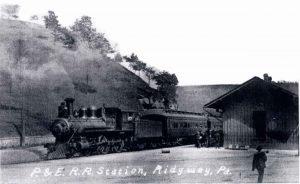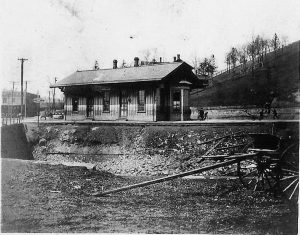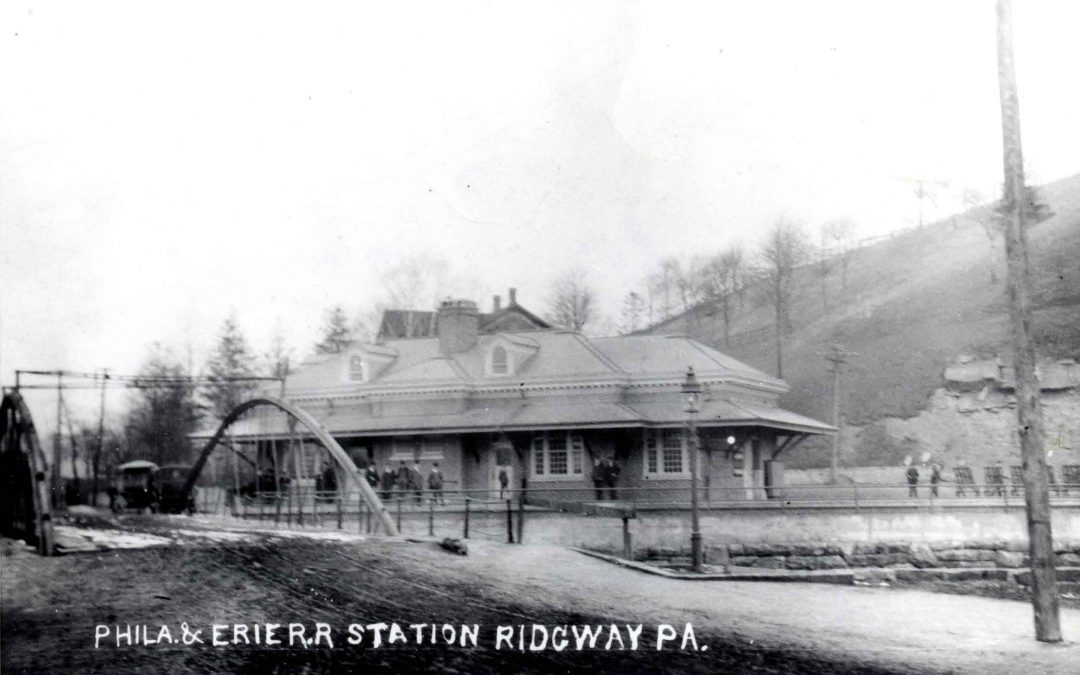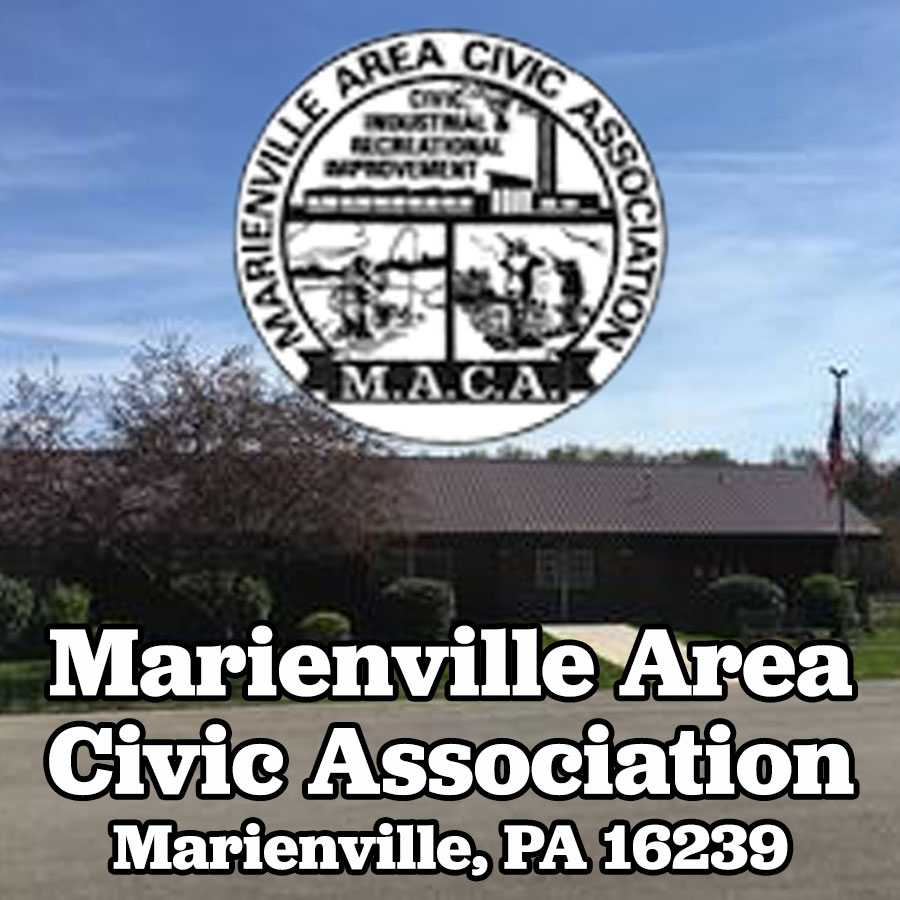By Bob Imhoff:
Ridgway, Elk County, Pennsylvania
The history of the Pennsylvania Railroad in Ridgway and Elk County began with the incorporation of the Sunbury and Erie Railroad on March 3, 1837 with the first meeting to discuss the railroad in northwestern Pennsylvania held in Ridgway, Elk County in the fall of 1845.
Due to financial problems, the company did not begin construction until the state passed enabling legislation, which including reducing tax assessments, in 1852. By December 1854, 28.5 miles (45.9 km) of track were completed between Milton (a junction with the Catawissa Railroad) and Williamsport. The line reached Sunbury in 1855, a total of 40 miles (64 km). The company continued to experience financial problems, exacerbated by the Panic of 1857. The tracks reached Lock Haven in 1859. To speed completion of the line, the Sunbury & Erie also started building towards the southeast from Erie. That portion of the line reached Warren, a distance of 66 miles, by 1859; little construction occurred in 1860 amid the politics leading to the American Civil War. In 1861 the Pennsylvania General Assembly passed additional legislation to strengthen the company’s financial position, and changed the company name to the Philadelphia and Erie Railroad (P&E).
 Other, related legislation authorized various railroad companies to lease the lines of other companies, and the Pennsylvania Railroad entered a 999-year lease with the Philadelphia & Erie in 1862. That same year the Pennsylvania Railroad assumed control of the P&E. Labor shortages due to the Civil War further delayed construction.
Other, related legislation authorized various railroad companies to lease the lines of other companies, and the Pennsylvania Railroad entered a 999-year lease with the Philadelphia & Erie in 1862. That same year the Pennsylvania Railroad assumed control of the P&E. Labor shortages due to the Civil War further delayed construction.
The railroad was opened for business between Emporium and St. Marys on May 2, 1864, opened from Kane to Wilcox on July 6, 1864 and finally completed from St. Marys to Ridgway to Wilcox on October 4, 1864 with the “Golden Spike” driven into the final rail at Tambine along the West Branch of the Clarion River. The Erie Union Station opened on October 1, 1865. The Philadelphia and Erie Railroad merged with the Pennsylvania Railroad on May 1, 1907. The New York Times suggested that the railroad would be a major route connecting trade for petroleum between northwestern Pennsylvania and Philadelphia.
Train Stations of the Sunbury & Erie and Philadelphia & Erie at Ridgway
This narrative history forms the basis for honoring the members of the community of Ridgway in the restoration of the Pennsylvania Railroad Station in Ridgway built in 1907.
 The original wood frame Philadelphia & Erie passenger station was in the area next to the now vacant Fire Hall on Front Street. In 1884 the station was moved 1/4 mile along Elk Creek and across Depot Street to the West, so it was closer to the junction with the Ridgway & Clearfield Railroad, a future division of the huge Pennsylvania Railroad system. The original freight station was on the west side of Broad Street. A larger freight house replaced it in the same location likely in 1907 when the new passenger station was constructed.
The original wood frame Philadelphia & Erie passenger station was in the area next to the now vacant Fire Hall on Front Street. In 1884 the station was moved 1/4 mile along Elk Creek and across Depot Street to the West, so it was closer to the junction with the Ridgway & Clearfield Railroad, a future division of the huge Pennsylvania Railroad system. The original freight station was on the west side of Broad Street. A larger freight house replaced it in the same location likely in 1907 when the new passenger station was constructed.
Beginning Process of Restoration
The first steps in restoring the Pennsylvania Railroad passenger terminal was a conversation at a Ridgway Heritage Council meeting with Main Street Manager Michelle Bogacki, who also served as a Board Member of the Heritage Council, to determine the potential of restoring the historic building that was faced with potential demolition. The Heritage Council and Main Street Manger coordinated with William Gentilman, Property Manager for the Buffalo & Pittsburgh Railroad, Inc. at the time and he stated “The station was built the last year (1907) the Philadelphia & Erie Railroad was in existence,” said Gentilman. “The line the station is on was a part of the Pennsylvania Railroad section that ran from Erie to St. Marys. In order to move the project forward coordination between the Borough of Ridgway, the Buffalo & Pittsburgh Railroad, the Ridgway Heritage Council and Main Street Manager Program began in earnest and funding sources were explored to initially stabilize the building and seek additional community involvement to save the terminal.
 Many hours of legal discussion between the various parties and outreach led to the involvement of Mr. Dennis D. Heindl of Ridgway in pledging $50,000 to start the restoration and begin a fund raising campaign for an escrow account to provide money to pay for materials as the work continued. The restoration of the building has been nearly 20 years in the making. “We are pleased we were able to come to an agreement with everyone,” Gentilman stated at the time. “We would have been forced to tear it down, and it probably would have been gone by now if the Heindl’s wouldn’t have come forward. “The initiative was made by Dennis Heindl who approached Buffalo & Pittsburgh Railroad, Inc. officials with the seeds for an agreement to save the landmark welcoming visitors to Ridgway. “The borough had filed charges against the railroad because of the deteriorated condition of the building. As a rebuttal, they were not going to fix it, but decided to tear it down,” Mr. Heindl said. “Personally, I couldn’t see that happening because it would be unacceptable to lose the station with so much history attached since this was the first of three railroads that helped spur Ridgway’s economic development when it was completed across the Allegheny Plateau in 1864. After 19 years of arguing between the borough and the railroad, I thought I would step up to the plate and maybe get this thing settled.”
Many hours of legal discussion between the various parties and outreach led to the involvement of Mr. Dennis D. Heindl of Ridgway in pledging $50,000 to start the restoration and begin a fund raising campaign for an escrow account to provide money to pay for materials as the work continued. The restoration of the building has been nearly 20 years in the making. “We are pleased we were able to come to an agreement with everyone,” Gentilman stated at the time. “We would have been forced to tear it down, and it probably would have been gone by now if the Heindl’s wouldn’t have come forward. “The initiative was made by Dennis Heindl who approached Buffalo & Pittsburgh Railroad, Inc. officials with the seeds for an agreement to save the landmark welcoming visitors to Ridgway. “The borough had filed charges against the railroad because of the deteriorated condition of the building. As a rebuttal, they were not going to fix it, but decided to tear it down,” Mr. Heindl said. “Personally, I couldn’t see that happening because it would be unacceptable to lose the station with so much history attached since this was the first of three railroads that helped spur Ridgway’s economic development when it was completed across the Allegheny Plateau in 1864. After 19 years of arguing between the borough and the railroad, I thought I would step up to the plate and maybe get this thing settled.”
With legal considerations resolved and initial funding in place, the community stepped up to start the extensive process of working on cleanup of the inside and outside of the building. This work included installing plywood painted black to cover the broken windows throughout the building, removing all the years of debris left on the inside and starting the plans for what the building would look like when completed. Fortunately, the workers had several photos of the building when it was originally constructed in 1907 to use as a template for their work including the rebuilding of the dormers that accented the roof line. Over a period of several months more volunteers than I can list worked many long hours to make the dream of a restored railroad terminal a reality. Theses volunteers are honored with a plaque attached to building listing their names, a well-deserved recognition of our community working together.

















